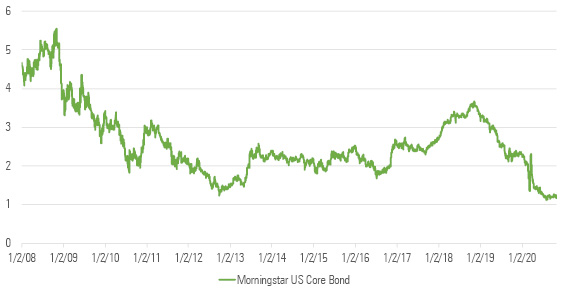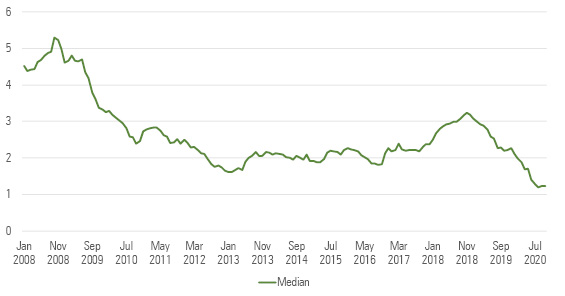With Yields So Low, Where Do You Go?
Intermediate core-bond investors should be cautious in this environment.

All else being equal, there are two ways investors can earn a return from a security: price appreciation, or income. With bumper demand for bonds driving market yields in the fixed-income markets to record lows, generating a sustainable income is harder for the typical bond manager to do without taking on significant credit or interest-rate risk. Fund shareholders would do well to keep this in mind when thinking about the fixed-income allocations of their portfolios.
Market observers across professions and platforms have noted the significant drop in yields in the fixed-income marketplace over the past several decades and especially since the global financial crisis of 2008. While there are a number of reasons for this phenomenon, one pertinent actor in this drama is the U.S. Federal Reserve. In response to the crisis, the Federal Open Market Committee slashed the federal-funds rate, the interest rate on which depository institutions trade balances with each other overnight, close to zero in early 2009 and it kept it there until late 2015. While the FOMC hiked rates on and off from 2016 through 2018, the FFR now once again sits in the near-zero range after being slashed in the wake of the coronavirus-related economic downturn of 2020.
These rate cuts, as noted by the St. Louis Fed, have the most direct effect on short-term interest rates and a more muted effect on long-term rates. This effect can be seen in the movements of various parts of the U.S. Treasury yield curve since 2008.
Exhibit 1: U.S. Treasury Rates
- source: U.S. Department of the Treasury
Both the three-month and one-year Treasuries have closely followed rate cuts and hikes from the FOMC over the period, with each yielding around 3% at the beginning of 2008 while yielding close to zero at the end of October 2020. While longer-dated Treasuries do not follow short-term interest-rate movements in lockstep, their yields too have dropped over the same period as demand for U.S. Treasuries has remained high over the past several years. The 10-year Treasury, which is often used as a barometer for the fixed-income market, began 2008 yielding 3.5% and ended the period yielding a mere 0.6%. Even the 30-year Treasury, which began the period yielding around 4%, yielded only slightly over 1.5% at the end of the period, briefly falling below 1% in March 2020. No matter what part of the curve, there isn’t much yield to be had in U.S. Treasuries these days.
Treasuries form a major chunk of the U.S. fixed-income market and are often bought in large quantities by managers. They also provide an effective floor to the yields of other fixed-income instruments given that they are commonly taken as the risk-free asset of the global securities market: All else being equal, all other fixed-income securities earn a yield premium to equally dated U.S. Treasuries owing to their higher risk of default. With Treasury rates as low as they are, the floor at which yields for other fixed-income securities can sit has also dropped to a historically low level. Alongside the voracious appetite for fixed-income securities of all stripes, this has driven yields in the broad fixed-income market to unseen levels.
Exhibit 2: Morningstar US Core Bond Effective Yield

- source: Morningstar Indexes, ICE Data Services
The yield of the Morningstar US Core Bond Index, which tracks a broad swath of U.S. government debt, investment-grade corporate bonds, and agency mortgages, began 2008 with an effective yield of 4.7% yet ended October 2020 with a figure of merely 1.2%. This tremendous yield compression was not only because of the fall in yields in the U.S. Treasury market but also owing to similarly compressed yields across agency mortgages and investment-grade corporate debt. Both the Morningstar US Mortgage-Backed Securities Index and Morningstar US Corporate Bond Index began the period with an effective yield figure of 5.5% and ended the figure hovering at or below 2%.
How You (and Your Bond Fund Manager) Are Affected How do these trends affect the average bond fund investor? There are two widely accepted figures fund managers use when reporting the income of their strategies: the trailing 12-month yield and the SEC yield. The TTM yield is a backward-looking figure that shows the distributions, including interest income, dividends, and capital gains, paid to investors over the trailing 12 months from the reporting date. The SEC yield, a calculation of the net investment income per share divided by the maximum offering price per share of a fund over the trailing 30-day period, can be used as an approximate forward-looking figure for bond funds. Assuming that each bond in the portfolio is held to maturity, the SEC yield figure roughly gives the income a bond fund investor would receive in a year.
The collapse of yields across the fixed-income market has meant that core-bond fund managers investing in U.S. Treasuries, agency mortgages, and corporate credit have fewer tools at their disposal when seeking to generate a high level of income. Looking at the median SEC yield of a group of distinct intermediate core bond Morningstar Category strategies illustrates this fact vividly.
Exhibit 3: Intermediate Core Bond SEC Yield

- source: Morningstar Data
The “typical” intermediate core-bond category strategy yielded around 4.5% at the beginning of 2008, relatively close to that of the Morningstar US Core Bond Index. Through the tumult of the global financial crisis, the subsequent bull market, and the coronavirus-related recession of 2020, this figure dropped to 1.2% by the end of October 2020. It is worth noting that this figure is the absolute lowest it has been since March 1990 (the earliest that our SEC yield data is published), when funds reported SEC yields ranging into the realm of 6%-8%.
This figure does not suggest there is a complete absence of total return in the bond market. Indeed, given that bond yields move inverse of bond prices, this yield compression is the result of a bull market for bond funds, wherein price appreciation has contributed to sizable gains for many participants over the period. But because yields across the fixed-income market are as low as they are, price appreciation will likely play an even smaller role in the typical core bond fund's total return today than it has in the past.
Beware Unusually High Yields So how should core-bond fund shareholders navigate this low-yield environment? The biggest takeaway is a classic maxim of the bond market: If the fund you're investing in has an unusually high yield, it's likely taking on potentially dangerous levels of credit and/or interest-rate risk.
As my colleague Eric Jacobson noted in this article from September 2020, core-bond funds are far more susceptible to interest-rate shocks due to the steady lengthening of the duration of the broad fixed-income market. If a core-bond fund is posting both a higher SEC yield and a longer effective duration than its rivals, this could be evidence of the strategy opening itself up to a higher drawdown should rates spike unexpectedly in the near future.
While the broad U.S. Treasury, agency mortgage, and investment-grade corporate credit indexes have seen their effective yields compress to extremely tight levels in recent months, the corporate bond market has largely offered a yield premium to securitized and government fare over the past decade. Many core-bond fund managers have thus flocked to this market in order to gain more yield than their rivals.
From January 2008 through October 2020, the percentage of assets in corporate bonds held by the typical intermediate core-bond strategy rose to just under 30% from 20%. This trend is not just because of managers seeking a yield premium from corporate bonds--it is also conceivable, given the growth of corporate bonds as a percentage of indexes like the Morningstar US Core Bond Index (where corporate bond exposure increased from 16% at the end of 2007 to 26% as of October 2020), that more funds would be inclined to increase their exposure to corporate debt to reduce their tracking error. Yet, in a world of rock-bottom yields both in securitized and U.S. Treasuries, the slight premium offered by corporate bonds most likely served as a lure for many core bond managers.
As managers have piled into corporate bonds for their higher yields, the resulting price appreciation in the space helped drive yields across the corporate bond market to record lows.
Exhibit 4: ICE Indexes Effective Yield
- source: ICE Data Indexes, St. Louis FRED
It isn’t surprising that the yield of the ICE Bank of America AAA Corporate Bond Index, representing a sampling of the highest-rated corporate bond issues, has consistently been lower than that of the near speculative-grade BBB index. At the end of October 2020, however, the spread between the two was extremely tight: The BBB Index yielded 2.2% whereas the AAA Index yielded only 60 basis points less at 1.6%. These BBB rated corporate credits tend to fall in value more sharply in credit shocks than higher-rated corporates, but the yields are so low that it may not be enough to compensate investors for the risk that certain managers have taken by concentrating heavily on that segment of the credit market. A manager concentrating heavily on BBB rated corporate credit, which has tended to fall in value much more sharply in credit shocks than other investment-grade corporate fare, is not gaining a significant yield premium to its staider peers.
So where are yields still elevated? The answer may be uncomfortable for investors seeking the relative safety of a core-bond fund holding. Only the riskiest parts of the fixed-income market, including low-quality securitized fare, high-yield corporate bonds, and leveraged loans, are posting yields much higher than those of the traditional investment-grade core bond sectors. As many investors were painfully reminded in March 2020, these issues offer juicier yields precisely because of their higher credit risk, and broad indexes tracking these sectors saw up to double-digit drops during the worst of the sell-off. While the intermediate core-bond category sets a strict 5% limit on debt rated BB and below, managers pushing to the limit of this ceiling in order to gain a higher yield may be putting their investors at relative risk.
Where do you go from here? Part of the job of the core-bond manager has always been balancing attractive yields without too much credit or interest-rate risk. With yields as low as they are across the fixed-income market, this job is harder than ever for even the most-seasoned investor.
This is not to say that any core-bond fund posting an SEC yield higher than its peers is taking on insurmountable levels of interest-rate or credit risk. When in doubt, it’s worth digging into a fund’s holdings in order to ascertain where the managers are taking on the greatest levels of interest-rate and credit risk--knowing these differences can be the key between sailing through or sinking during a market drawdown. My colleague Sam Kulahan wrote this piece showing how you can use Morningstar’s Fixed-Income Exposure Analysis tool to dig deeper into where a core bond fund is taking on risk.
As is always the case with fund investing, fund investors ignore the price tags levied by their investment managers at their peril. Given that SEC yields are net of fees, a pertinent maxim comes to mind: The higher the fees charged by your fund manager, the greater risks they will need to take in order to deliver the same level of yield (and return) than a cheaper competitor.
While the world of fixed-income investing has changed quite significantly over the past 15 years, the advice we give to the fixed-income fund investor remains the same: If a fund’s yield looks too good to be true, it probably is. There is no free lunch in bond fund investing, and investors today must accept that higher yields mean higher risk. A core-bond fund that advertises a far higher yield figure than its index or peers may be employing tactics like going long on duration or low on the credit quality spectrum; those doing so with a middling to heavy price tag might be utilizing even riskier methods. Low yields in the broad fixed-income market mean that, all else being equal, the core-bond fund investor is likely to earn a lower yield and return on their bond portfolio than they have in the past. Investors who require an extra yield boost to meet their goals will need to accept more risk with allocations to junk-rated corporates or even equities. Those that do not, however, would be better-served sticking with conservative bond funds that sport experienced teams, sensible investment processes, and low fees.

/s3.amazonaws.com/arc-authors/morningstar/0958c43c-2dc5-46a0-b177-cde33d8349e5.jpg)
/cloudfront-us-east-1.images.arcpublishing.com/morningstar/HDPMMDGUA5CUHI254MRUHYEFWU.png)
/cloudfront-us-east-1.images.arcpublishing.com/morningstar/OMVK3XQEVFDRHGPHSQPIBDENQE.jpg)
:quality(80)/s3.amazonaws.com/arc-authors/morningstar/0958c43c-2dc5-46a0-b177-cde33d8349e5.jpg)